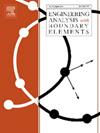Shaping quasi-transparent nanotubes into Maximally strong EM scatterers
IF 4.2
2区 工程技术
Q1 ENGINEERING, MULTIDISCIPLINARY
Engineering Analysis with Boundary Elements
Pub Date : 2025-02-15
DOI:10.1016/j.enganabound.2025.106153
引用次数: 0
Abstract
The problem of enhancing the electromagnetic (EM) scattering for almost transparent nanotubes via shape modification of their cross section, is studied in this work. An isogeometric analysis approach, in a boundary element method setting, is employed to evaluate the local electric field, which is expressed in terms of the exact same basis functions utilized in the geometric representation of the cylinder boundary. In this way, the overall scattering power becomes computable via proper integration of the far field magnitude around the nanotube and shape optimization can be directly performed with the aim of maximizing the scattering enhancement compared to an equiareal circular nanotube. The optimization framework uses: (i) a hybrid approach combining global optimizers with gradient-based local algorithms for accurately determining the shape at the final stages, (ii) a series of parametric models generating valid non-self-intersecting nanotube shapes, and (iii) an isogeometric-enabled boundary element method solver approximating the value of the electric field with high accuracy. The optimized nanotube shapes give much higher total scattering response than their circular counterparts. In a wide range of operating conditions (such as nanotube’s electric conductivity or cross section area), the optimized shapes assumed a distinct spiky shape which was further studied with respect to the direction of excitation. Apart from boosting scattering for quasi-transparent nanotubes, the developed methodology can be adapted to solve the inverse problem, namely, determining the nanotube shape from its scattering signal, as well as extended to address similar problems with finite arrays of nanotubes comprising EM metasurfaces.
将准透明纳米管塑造成最强的电磁散射体
本文研究了通过改变纳米管的截面形状来增强其电磁散射的问题。采用边界元法设置的等几何分析方法来计算局部电场,该局部电场用与圆柱边界几何表示完全相同的基函数表示。这样,通过适当地积分纳米管周围的远场大小,可以计算总体散射功率,并且可以直接进行形状优化,以最大限度地提高与等圆纳米管相比的散射增强。优化框架使用:(i)结合全局优化器和基于梯度的局部算法的混合方法,在最后阶段精确确定形状,(ii)一系列参数模型生成有效的非自相交纳米管形状,以及(iii)具有等几何特性的边界元方法求解器,以高精度逼近电场值。优化后的纳米管比圆形纳米管具有更高的总散射响应。在很宽的工作条件下(如纳米管的电导率或横截面面积),优化后的形状呈现出明显的尖尖形状,并进一步研究了其与激发方向的关系。除了增强准透明纳米管的散射外,所开发的方法还可以适用于解决反问题,即从其散射信号确定纳米管的形状,并扩展到解决由EM超表面组成的纳米管有限阵列的类似问题。
本文章由计算机程序翻译,如有差异,请以英文原文为准。
求助全文
约1分钟内获得全文
求助全文
来源期刊

Engineering Analysis with Boundary Elements
工程技术-工程:综合
CiteScore
5.50
自引率
18.20%
发文量
368
审稿时长
56 days
期刊介绍:
This journal is specifically dedicated to the dissemination of the latest developments of new engineering analysis techniques using boundary elements and other mesh reduction methods.
Boundary element (BEM) and mesh reduction methods (MRM) are very active areas of research with the techniques being applied to solve increasingly complex problems. The journal stresses the importance of these applications as well as their computational aspects, reliability and robustness.
The main criteria for publication will be the originality of the work being reported, its potential usefulness and applications of the methods to new fields.
In addition to regular issues, the journal publishes a series of special issues dealing with specific areas of current research.
The journal has, for many years, provided a channel of communication between academics and industrial researchers working in mesh reduction methods
Fields Covered:
• Boundary Element Methods (BEM)
• Mesh Reduction Methods (MRM)
• Meshless Methods
• Integral Equations
• Applications of BEM/MRM in Engineering
• Numerical Methods related to BEM/MRM
• Computational Techniques
• Combination of Different Methods
• Advanced Formulations.
 求助内容:
求助内容: 应助结果提醒方式:
应助结果提醒方式:


